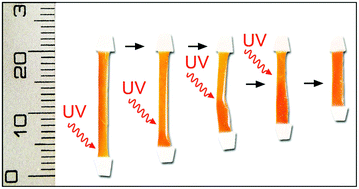Optically and thermally activated shape memory supramolecular liquid crystalline polymers
Abstract
We investigated the shape memory properties of a supramolecular side-chain liquid crystalline polymer (SCLCP) prepared by tethering two azobenzene mesogens, namely 4-(4′-heptylphenyl) azophenol (7PAP) and 4-(4′-ethoxyphenyl) azophenol (2OPAP), to poly(4-vinyl pyridine) (P4VP) through H-bonding. The results revealed that despite the dynamic nature of the linking H-bonds, the supramolecular SCLCP behaves similarly to a covalent SCLCP by exhibiting a two-stage thermally triggered shape recovery process governed by both glass transition and LC-isotropic phase transition. The ability of the supramolecular SCLCP to store part of the strain energy above Tg in the LC phase enables it to exhibit triple-shape memory properties. Moreover, thanks to the used azobenzene mesogens that can undergo trans–cis photoisomerization, exposing the supramolecular SCLCP to UV light (365 nm) can also trigger the shape recovery process, thus enabling the remote activation and the spatiotemporal control of the shape memory. By measuring the contractile force and its disappearance in an elongated film under constant strain upon turning on and off the UV light, respectively, it appears that the optically triggered shape recovery stems from a combination of a photothermal effect and an effect of photoplasticization or order–disorder phase transition resulting from the trans–cis photoisomerization of azobenzene mesogens.


 Please wait while we load your content...
Please wait while we load your content...